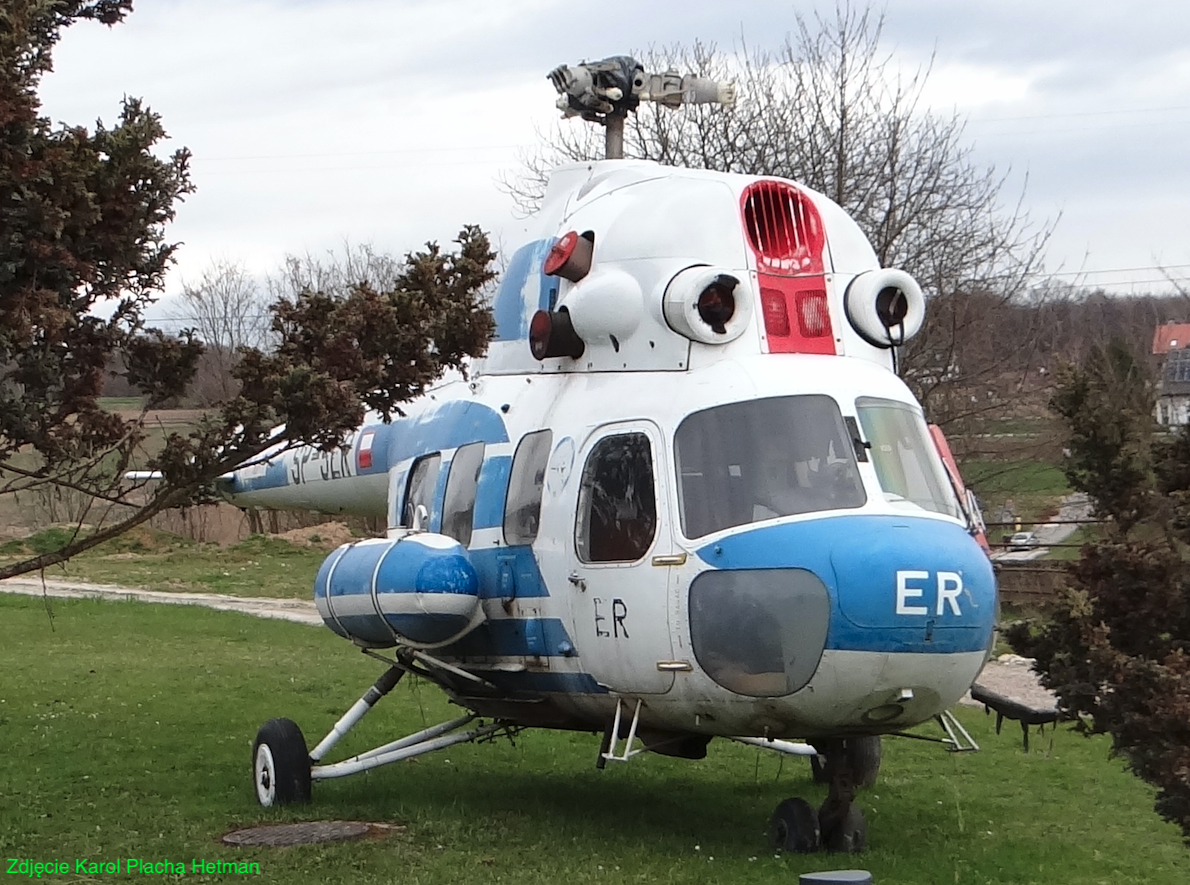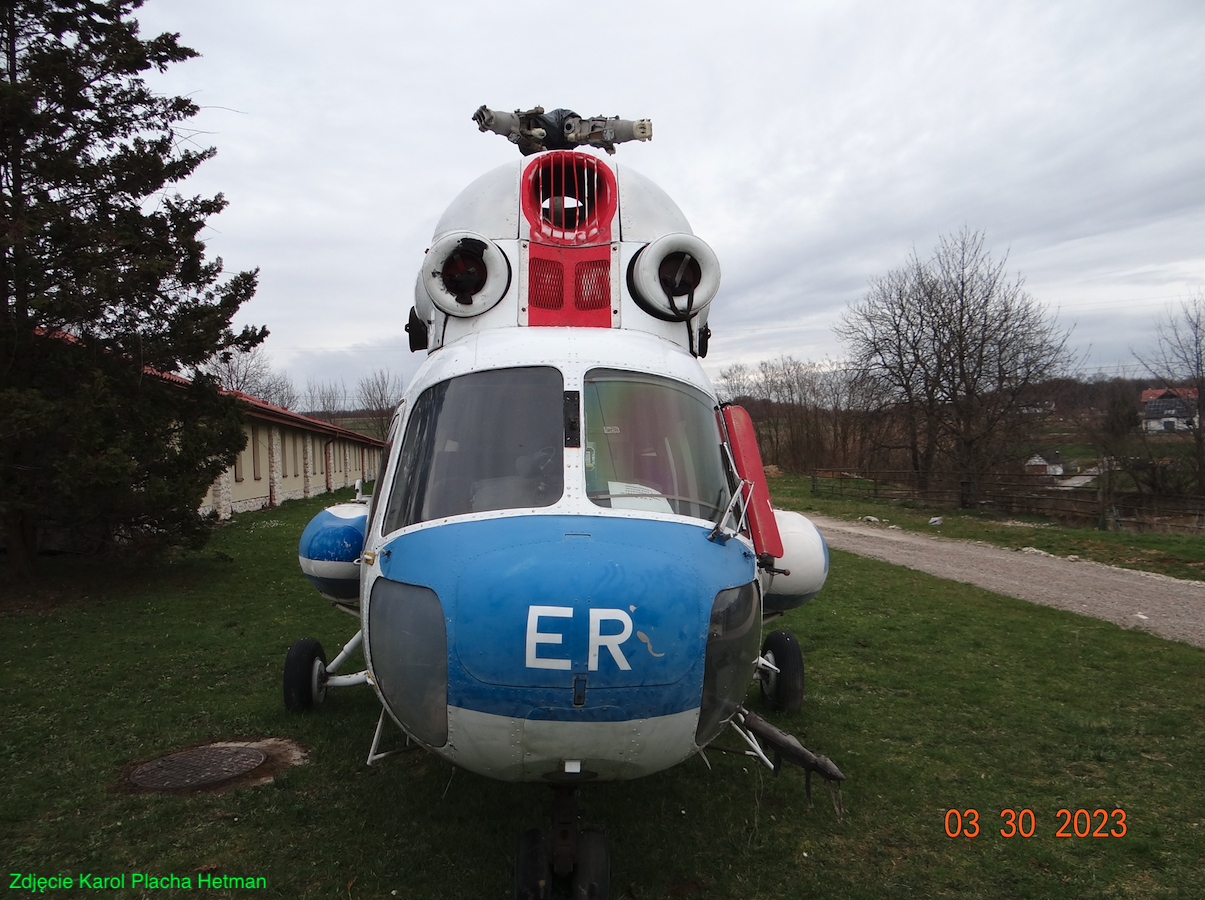Tomaszowice 2023-04-05
WSK PZL Świdnik Mi-2 SP-SER.
PZL Mi-2 helicopter No. 544535125, registration SP-SER, was produced in 1975. He originally served at the Institute of Aviation in Warsaw. Then it was transferred to KGHM. The total flight time was 3,254 hours, and the flight time since the last overhaul was 1,265 hours. The helicopter has been deregistered and is currently (2023) presented at an outdoor exhibition in the Manor House in Tomaszowice. The helicopter is in its original livery; white - blue.




History Mi-2.
The Mil Mi-2 helicopter is one of the most recognizable helicopters in the world. In the NATO code Mi-2 was named Hoplite. (Hoplite is a heavily armed foot soldier in ancient Greece from the 7th to the 4th century BC). The helicopter also received several dialectal names, including the most popular "Kettle". It was designed at CCCP in Mikhail Mil's office. The helicopter turned out to be successful and a decision was made about its serial production. However, the CCCP's economy was inefficient, and the munitions plants were burdened with more urgent production. Therefore, a decision was made to locate the production of the Mi-2 helicopter in WSK PZL Świdnik. The decision was supported by Świdnik's experience gained in the production of SM-1 and SM-2 helicopters. There was also another advantage for the communists; It was possible to significantly reduce Polish research and development work on domestic structures. In effect; each Mi-2 was built in Świdnik. In 1963, final decisions were made and the Mi-2 helicopter license was purchased. The Soviets did not agree to give the machine the name SM-3, which was provided for it in Poland.
In 1964, WSK PZL Świdnik started the production of Mi-2 helicopters from parts delivered from CCCP. In 1965, the first completely Polish Mi-2 rolled off the production line. In total, about 5,400 Mi-2 helicopters in various versions were built. Originally, the helicopter was designed as a civilian machine. But in Świdnik, several variants were developed for the army and they were mainly produced and used by the Polish Army and other countries. Although the design of the Mi-2 is already obsolete, it is still (2023) in the military and civil services of many countries.
The reason for the creation of the new helicopter was the development of a new turbine engine with the designation GTD-350. The Mi-2 helicopter was not the first CCCP helicopter with this type of drive. The first was the Mil Mi-6, one of the largest helicopters in the world. Contrary to popular opinion, the Mi-2 helicopter was not designed as a light helicopter. After all, it was supposed to take up to 9 people on board. A light helicopter at that time was the Mil Mi-1, for 3-4 people, produced in Poland until 1965, and in CCCP until 1970. The fact that after some time the Mi-2 displaced the Mi-1 from use was the result of its operational advantages. In addition, its twin-engine drive significantly increased safety during the flight. The development of the Mil Mi-2 helicopter was more of an experiment than a specific goal. Because turbine-powered helicopters were a big novelty and all companies building this type of aircraft started working in this direction.
Work on the Mil Mi-2 was started in 1959. In January 1961, a mock-up of the helicopter was approved. In February 1961, the documentation for the construction of the prototype was ready. The first flight of the prototype took place on September 22, 1961.
One of the first prototype versions of the Mi-2 was the agricultural version. Her rehearsals were carried out in one of the kolkhozes near Moscow in 1962. The helicopter received installations for dusting with fertilizers. In September 1962, this helicopter was demonstrated to the CCCP party and government authorities. In May 1963, one of the prototypes set a world speed record on a 100 km closed course, setting a result of 253,800 km/h.
Prototype documentation was sent to Poland, to WSK PZL Świdnik. It was necessary to translate it into Polish and complete the entire production documentation. All instrumentation, assembly stations, control and measurement stations had to be made. After the prototypes were built, static and flight tests had to be performed. The same scope of work was performed at WSK PZL Rzeszów in relation to the GTD-350 engines and the WR-2 main transmission.
On August 26, 1965, the first Mi-2 helicopter built in Świdnik with parts delivered from CCCP was flown. The crew consisted of Soviet pilots Rafail Karapatian and Belusov. On November 4, 1965, the first one produced entirely in Świdnik (serial no. 520001) was flown. The crew consisted of: test pilot mgr inż. Wieslaw Mercik, MSc. Eng. Kazimierz Moskowicz and Henryk Jaworski.
Serial production of Mi-2 helicopters lasted from 1964 to 1991, and after a break, briefly until 2005.
T-T Mi-2 data:
Diameter of the main rotor 14.56 m. Total length 17.42 m. Length of the fuselage 11.94 m. Width of the fuselage 3.25 m. Height without tail rotor 3.75 m. Curb weight 2,375 kg. Take-off weight 3,550 kg. Payload weight 700 kg. Fuel in internal tanks 600 liters. Top speed 210 km/h. Cruising speed 190 km/h. Vertical climb 4.6 m/s. Service ceiling 4,000 m. Hovering ceiling without ground effect 900 m. Hovering ceiling with ground effect 1,600 m. Range 300 km. Maximum range 600 km.
PZL Mi-2 helicopter No. 5311149108 registration SP-SFW. 1998.
In March 2019, KGHM Polska Miedź S.A., 59-301 Lubin, ul. M. Skłodowskiej-Curie 48 informed that it has for sale a PZL Mi-2 helicopter, registration SP-SFW and a PZL Mi-2 helicopter, registration SP-SER. The helicopters were put up for sale in the auction system. The helicopters were used in the Hydrotechnical Plant of KGHM Polska Miedź. The helicopters were based at the airport in the city of Lubin.
The PZL Mi-2 helicopter No. 5311149108, registration SP-SFW, was manufactured in 1998, on a special order of the Pol-Miedź Trans plant in Lubin. The helicopter then went to the Hydrotechnical Plant of KGHM Polska Miedź S.A. in Rudna. The helicopter was equipped with, among others, a Bambi extinguishing tank, a spraying system and a number of other specialized equipment. Mi-2 helicopter, worked in the Hydrotechnical Plant, which is responsible for servicing the "Żelazny Most" reservoir.
"Żelazny Most" is the largest and best monitored post-flotation waste tank in Europe. Its operation began in 1977, together with the so-called Southern Headquarters added to the Main Facility, it covers an area of over 2,000 hectares. The reservoir is surrounded on all sides by earth dams, over 20 km long and 54 to 76 m high. About 30 million tons of post-flotation waste are dumped at the facility annually.
The PZL Mi-2 helicopter, registration SP-SFW, ended its flights in 2019 and was deregistered. The machine was put up for sale in the auction system. The helicopter has not been sold.
Spare parts were also offered for the helicopters: fuel pumps, main gears, intermediate gears, rear gears, control discs and others. The engines had more than 2,000 hours of service and had to be overhauled. The main transmission of the WR-2 was also to be overhauled. In addition, spraying equipment was offered for sale, consisting of two tanks for chemicals and a spraying installation.
PZL Mi-2 helicopter No. 544535125 registration SP-SER. 1975.
PZL Mi-2 helicopter No. 544535125, registration SP-SER, was produced in 1975. He originally served at the Institute of Aviation in Warsaw. Then it was transferred to the KGHM company. The total flight time was 3,254 hours, and the flight time since the last overhaul was 1,265 hours. The helicopter has been deregistered. The helicopter is in its original livery; white - blue.
In the helicopter, both engines, main gear, intermediate gear, propeller shafts, fuel pumps, swashplate and others were to be repaired. Batteries, chassis shock absorbers, tires had to be replaced. Spare parts were offered for the helicopter: main rotor hub, swash plate, hydraulic block, oil cooler, KX-155 radio, KT-76A transponder, GPS-155 and others.
There are no buyers for helicopters. Therefore, the KGHM Polska Miedź Foundation donated both helicopters as a gift to the Rescue Museum. Currently (2023) the helicopters are presented at an outdoor exhibition in the Manor House in Tomaszowice near Krakow.
Written by Karol Placha Hetman
